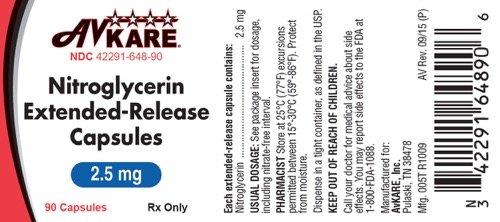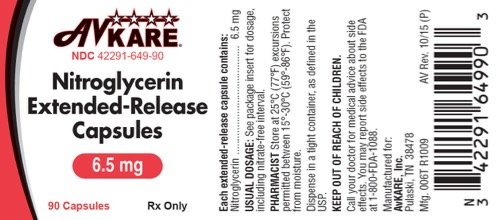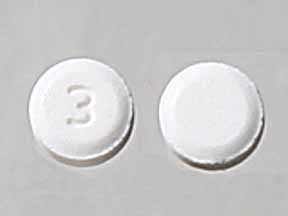Nitroglycerin ER: Package Insert / Prescribing Info
Package insert / product label
Generic name: nitroglycerin
Dosage form: capsule, extended release
Drug classes: Antianginal agents, Vasodilators
Medically reviewed by Drugs.com. Last updated on Jun 2, 2025.
On This Page
Nitroglycerin ER Description
Nitroglycerin is 1,2,3-propanetriol trinitrate, an organic nitrate whose structural formula is Molecular Structure:
Nitroglycerin ER - Clinical Pharmacology
The principal pharmacological action of nitroglycerin is relaxation of vascular smooth muscle and consequent dilation of peripheral arteries and veins, especially the latter. Dilatation of the veins promotes peripheral pooling of blood and decreases venous return to the heart, thereby reducing left ventricular end-diastolic pressure and pulmonary capillary wedge pressure (preload). Arteriolar relaxation reduces systemic vascular resistance, systolic arterial pressure, and mean arterial pressure (afterload). Dilatation of the coronary arteries also occurs. The relative importance of preload reduction, afterload reduction, and coronary dilatation remains undefined. Dosing regimens for most chronically used drugs are designed to provide plasma concentrations that are continuously greater than a minimally effective concentration. This strategy is inappropriate for organic nitrates. Several well-controlled clinical trials have used exercise testing to assess the anti-anginal efficacy of continuously-delivered nitrates. In the large majority of these trials, active agents were indistinguishable from placebo after 24 hours (or less) of continuous therapy. Attempts to overcome nitrate tolerance by dose escalation, even to doses far in excess of those used acutely, have consistently failed. Only after nitrates had been absent from the body for several hours was their anti-anginal efficacy restored.
Pharmacokinetics: The volume of distribution of nitroglycerin is about 3 L/kg, and nitroglycerin is cleared from this volume at extremely rapid rates, with a resulting serum half-life of about 3 minutes. The observed clearance rates (close to 1 L/kg/min) greatly exceed hepatic blood flow; known sites of extrahepatic metabolism include red blood cells and vascular walls.
The first products in the metabolism of nitroglycerin are inorganic nitrate, and the 1,2- and 1,3-dinitroglycerols. The dinitrates are less effective vasodilators than nitroglycerin, but they are longer-lived in the serum, and their net contribution to the overall effect of chronic nitroglycerin regimens is not known. The dinitrates are further metabolized to (non-vasoactive) mononitrates and, ultimately, to glycerol and carbon dioxide.
To avoid development of tolerance to nitroglycerin, drug-free intervals of 10-12 hours are known to be sufficient; shorter intervals have not been well studied. In one well-controlled clinical trial, subjects receiving nitroglycerin appeared to exhibit a rebound or withdrawal effect, so that their exercise tolerance at the end of the daily drug-free interval was less than that exhibited by the parallel group receiving placebo.
Reliable assay techniques for plasma nitroglycerin levels have only recently become available, and studies using these techniques to define the pharmacokinetics of oral nitroglycerin preparations have not been reported. Published studies using older techniques provide results that often differ, in similar experimental settings, by an order of magnitude.
Clinical Trials: Controlled trials of single oral doses of nitroglycerin have demonstrated that nitroglycerin capsules can effectively reduce exercise-related angina for up to 5 hours. Anti-anginal activity is present about 1 hour after ingestion of a capsule.
Controlled trials of multiple-dose oral nitroglycerin have shown statistically significant anti-anginal efficacy 2½ and 4 hours after a dose when oral nitroglycerin had been administered four times a day for 2 weeks or three times a day for 1 week. As noted above, careful studies with other formulations of nitroglycerin have shown that maintenance of continuous 24-hour plasma levels of nitroglycerin results in insurmountable tolerance. Presumably, the studied 1-week and 2-week regimens of oral nitroglycerin therapy achieved adequate nitrate-free intervals by non-uniformity of dosing interval, with longer intervals overnight. The investigators did not report how subjects interpreted their dosing instructions, and they similarly did not report which dose of the day was the one after which they obtained the end-of-trial exercise results.
Thus, these studies of oral nitroglycerin should not be interpreted as demonstrations that these regimens provide round-the-clock anti-anginal protection. From large, well-controlled studies of other nitroglycerin formulations, it is reasonable to believe that the maximal achievable daily duration of anti-anginal effect from Nitroglycerin Extended-Release Capsules is about 12 hours.
In some controlled trials of other organic nitrate formulations, efficacy has declined with time. Because the controlled, multiple-dose trials of oral nitroglycerin did not include exercise tests before the last day of treatment, it is not known how the efficacy of Nitroglycerin Extended-Release Capsules may vary during extended therapy.
Indications and Usage for Nitroglycerin ER
Nitroglycerin Extended-Release Capsules are indicated for the prevention of angina pectoris due to coronary artery disease. The onset of action of oral nitroglycerin is not sufficiently rapid for this product to be useful in aborting an acute anginal episode.
Contraindications
Allergic reactions to organic nitrates are extremely rare, but they do occur. Nitroglycerin is contraindicated in patients who are allergic to it.
Warnings
The benefits of oral nitroglycerin in patients with acute myocardial infarction or congestive heart failure have not been established. If one elects to use nitroglycerin in these conditions, careful clinical or hemodynamic monitoring must be used to avoid the hazards of hypotension and tachycardia.
Because the effects of capsules are so difficult to terminate rapidly, they are not recommended in these settings.
Precautions
General: Severe hypotension, particularly with upright posture, may occur with even small doses of nitroglycerin. This drug should therefore be used with caution in patients who may be volume depleted or who, for whatever reason, are already hypotensive. Hypotension induced by nitroglycerin may be accompanied by paradoxical bradycardia and increased angina pectoris.
Nitrate therapy may aggravate the angina caused by hypertrophic cardiomyopathy.
As tolerance to other forms of nitroglycerin develops, the effect of sublingual nitroglycerin on exercise tolerance, although still observable, is somewhat blunted.
In industrial workers who have had long-term exposure to unknown (presumably high) doses of organic nitrates, tolerance clearly occurs. Chest pain, acute myocardial infarction, and even sudden death have occurred during temporary withdrawal of nitrates from these workers, demonstrating the existence of true physical dependence.
Some clinical trials in angina patients have provided nitroglycerin for about 12 continuous hours of every 24-hour day. During the nitrate-free intervals in some of these trials, anginal attacks have been more easily provoked than before treatment, and patients have demonstrated hemodynamic rebound and decreased exercise tolerance. The importance of these observations to the routine, clinical use of oral nitroglycerin is not known.
Information for Patients: Daily headaches sometimes accompany treatment with nitroglycerin. In patients who get these headaches, the headaches are a marker of the activity of the drug. Patients should resist the temptation to avoid headaches by altering the schedule of their treatment with nitroglycerin, since loss of headache is likely to be associated with simultaneous loss of anti-anginal efficacy.
Treatment with nitroglycerin may be associated with lightheartedness on standing, especially just after rising from a recumbent or seated position. This effect may be more frequent in patients who have also consumed alcohol.
Drug Interactions: The vasodilating effects of nitroglycerin may be additive with those of other vasodilators. Alcohol, in particular, has been found to exhibit additive effects of this variety.
Marked symptomatic orthostatic hypotension has been reported when calcium channel blockers and organic nitrates were used in combination. Dose adjustments of either class of agents may be necessary,
Carcinogenesis, Mutagenesis, and Impairment of Fertility: Studies to evaluate the carcinogenic or mutagenic potential of Nitroglycerin have not been performed. Nitroglycerin's effect upon reproductive capacity is similarly unknown.
Nursing Mothers: It is not known whether nitroglycerin is excreted in human milk. Because many drugs are excreted in human milk, caution should be exercised when nitroglycerin is administered to a nursing woman.
Geriatric Use: Clinical studies of Nitroglycerin Extended-release Capsules did not include sufficient numbers of subjects aged 65 and over to determine whether they respond differently from younger subjects. Other reported clinical experience has not identified differences in responses between the elderly and younger patients. In general, dose selection for an elderly patient should be cautious, usually starting at the low end of the dosing range, reflecting the greater frequency of decreased hepatic, renal, or cardiac function, and of concomitant disease or other drug therapy.
Adverse Reactions/Side Effects
Adverse reactions to nitroglycerin are generally dose-related, and almost all of these reactions are the result of nitroglycerin's activity as a vasodilator. Headache, which may be severe, is the most commonly reported side effect. Headache may be recurrent with each, daily dose, especially at higher doses. Transient episodes of lightheadedness, occasionally related to blood pressure changes, may also occur. Hypotension occurs infrequently, but in some patients it may be severe enough to warrant discontinuation of therapy. Syncope, crescendo angina, and rebound hypertension have been reported but are uncommon.
Allergic reactions to nitroglycerin are also uncommon, and the great majority of those reported have been cases of contact dermatitis or fixed drug eruptions in patients receiving nitroglycerin in ointments or patches. There have been a few reports of genuine anaphylactoid reactions, and these reactions can probably occur in patients receiving nitroglycerin by any route.
Extremely rarely, ordinary doses of organic nitrates have caused methemoglobinemia in normal-seeming patients; for further discussion of its diagnosis and treatment, see OVERDOSAGE.
Data are not available to allow estimation of the frequency of adverse reactions during treatment with Nitroglycerin Extended-Release Capsules.
To report SUSPECTED ADVERSE REACTIONS contact AvKARE, Inc. at 1-855-361-3993; email drugsafety@avkare.com; or FDA at 1-800-FDA-1088 or www.fda.gov/medwatch.
Related/similar drugs
Overdosage
Hemodynamic Effects: The ill effects of nitroglycerin overdose are generally the result of nitroglycerin's capacity to induce vasodilation, venous pooling, reduced cardiac output, and hypotension, These hemodynamic changes may have protean manifestations, including increased intracranial pressure, with any or all of persistent throbbing headache, confusion, and moderate fever; vertigo; palpitations; visual disturbances; nausea and vomiting (possibly with colic and even bloody diarrhea); syncope (especially in the upright posture); air hunger and dyspnea, later followed by reduced ventilatory effort; diaphoresis, with the skin either flushed or cold and clammy; heart block and bradycardia; paralysis; coma; seizures; and death.
Laboratory determinations of serum levels of nitroglycerin and its metabolites are not widely available, and such determinations have, in any event, no established role in the management of nitroglycerin overdose.
No data are available to suggest physiological maneuvers (e.g., maneuvers to change the pH of the urine) that might accelerate elimination of nitroglycerin and its active metabolites. Similarly, it is not known which – if any – of these substances can usefully be removed from the body by hemodialysis.
No specific antagonist to the vasodilator effects of nitroglycerin is known, and no intervention has been the subject of controlled study as a therapy of nitroglycerin overdose. Because the hypotension associated with nitroglycerin overdose is the result of venodilation and arterial hypovolemia, prudent therapy in this situation should be directed toward increase in central fluid volume. Passive elevation of the patients legs may be sufficient, but intravenous infusion of normal saline or similar fluid may also be necessary.
The use of epinephrine or other arterial vasoconstrictors in this setting is likely to do more harm than good.
In patients with renal disease or congestive heart failure, therapy resulting in central volume expansion is not without hazard. Treatment of nitroglycerin overdose in these patients may be subtle and difficult, and invasive monitoring may be required.
Methemoglobinemia: Nitrate ions liberated during metabolism of nitroglycerin can oxidize hemoglobin into methemoglobin. Even in patients totally without cytochrome b 5 reductase activity; however, and even assuming that the nitrate moieties of nitroglycerin are quantitatively applied to oxidation of hemoglobin, about 1 mg/kg of nitroglycerin should be required before any of these patients manifests clinically significant (≥10%) methemoglobinemia. In patients with normal reductase function, significant production of methemoglobin should require even larger doses of nitroglycerin. In one study in which 36 patients received 2 to 4 weeks of continuous nitroglycerin therapy at 3.1 to 4.4 mg/hr, the average methemoglobin level measured 0.2%; this was comparable to that observed in parallel patients who received placebo.
Notwithstanding these observations, there are case reports of significant methemoglobinemia in association with moderate overdoses of organic nitrates. None of the affected patients had been thought to be unusually susceptible. Methemoglobin levels are available from most clinical laboratories. The diagnosis should be suspected in patients who exhibit signs of impaired oxygen delivery despite adequate cardiac output and adequate arterial p0 2. Classically, methemoglobinemic blood is described as chocolate brown, without color change on exposure to air.
When methemoglobinemia is diagnosed, the treatment of choice is methylene blue, 1 to 2 mg/kg intravenously.
Nitroglycerin ER Dosage and Administration
As noted above ( CLINICAL PHARMACOLOGY) careful studies with other formulations of nitroglycerin have shown that maintenance of continuous 24-hour plasma levels of nitroglycerin results in tolerance (i.e., loss of clinical response). Every dosing regimen for Nitroglycerin Extended-Release Capsules should provide a daily nitrate-free interval to avoid the development of this tolerance. The minimum necessary length of such an interval has not been defined, but studies with other nitroglycerin formulations have shown that 10 to 12 hours is sufficient. Large controlled studies with other formulations of nitroglycerin show that no dosing regimen with Nitroglycerin Extended-Release Capsules should be expected to provide more than about 12 hours of continuous anti-anginal efficacy per day.
The pharmacokinetics of Nitroglycerin capsules, and the clinical effects of multiple-dose regimens, have not been well studied. In clinical trials, the initial regimen of Nitroglycerin has been 2.5 to 6.5 mg three to four times a day, with subsequent upward dose adjustment guided by symptoms and side effects. In one trial, 5 of the 18 subjects were titrated up to a dose of 26 mg four times a day.
How is Nitroglycerin ER supplied
2.5 mg, Nitroglycerin Extended-Release (Pink and Clear capsules imprinted TCL-1221) in bottles of 90. NDC 42291-648-90
6.5 mg, Nitroglycerin Extended-Release (Blue and Yellow capsules imprinted TCL-1222) in bottles of 90. NDC 42291-649-90
9 mg, Nitroglycerin Extended-Release (Green and Yellow capsules imprinted TCL-1223)
Rx only
Storage and Handling
Store at controlled room temperature 15° - 30° C (59° - 86° F).
Dispense in a tight container, as defined in the USP.
Manufactured for:
AvKARE, Inc.
Pulaski, TN 38478
Mfg. Rev. 03/05
AV Rev. 01/16 (P)
PACKAGE LABEL.PRINCIPAL DISPLAY PANEL
AvKARE
NDC
42291-648-90
Nitroglycerin Extended-Release Capsules
2.5 mg
90 Capsules
Rx Only
Each extended-release capsule contains:
Nitroglycerin.....2.5 mg
USUAL DOSAGE: See package insert for dosage, including nitrate-free interval.
PHARMACIST Store at 25
oC (77
oF) excursions permitted between 15
o-30
oC (59
o-86
oF). Protect from moisture.
Dispense in a tight container, as defined in USP.
KEEP OUT OF REACH OF CHILDREN.
Call your doctor for medical advice about side effects. You may report side effects to the FDA at 1-800-FDA-1088.
Manufactured for:
AvKARE, Inc.
Pulaski, TN 38478
Mfg. 005T R1009 AV Rev. 09/15 (P)
N3 4229164890 6

AvKARE
NDC
42291-649-90
Nitroglycerin Extended-Release Capsules
6.5 mg
90 Capsules
Rx Only
Each extended-release capsule contains:
Nitroglycerin.....6.5 mg
USUAL DOSAGE: See package insert for dosage, including nitrate-free interval.
PHARMACIST Store at 25
oC (77
oF) excursions permitted between 15
o-30
oC (59
o-86
oF). Protect from moisture.
Dispense in a tight container, as defined in USP.
KEEP OUT OF REACH OF CHILDREN.
Call your doctor for medical advice about side effects. You may report side effects to the FDA at 1-800-FDA-1088.
Manufactured for:
AvKARE, Inc.
Pulaski, TN 38478
Mfg. 006T R1009 AV Rev. 10/15 (P)
N3 4229164990 3

| NITROGLYCERIN
ER
nitroglycerin capsule |
||||||||||||||||||||||||||
|
||||||||||||||||||||||||||
|
||||||||||||||||||||||||||
|
||||||||||||||||||||||||||
|
||||||||||||||||||||||||||
|
||||||||||||||||||||||||||
|
||||||||||||||||||||||||||
| NITROGLYCERIN
ER
nitroglycerin capsule |
||||||||||||||||||||||||||
|
||||||||||||||||||||||||||
|
||||||||||||||||||||||||||
|
||||||||||||||||||||||||||
|
||||||||||||||||||||||||||
|
||||||||||||||||||||||||||
|
||||||||||||||||||||||||||
| Labeler - AvKARE (796560394) |
Frequently asked questions
- How do you take GoNitro to treat an angina attack (chest pain)?
- What is the shelf life of nitroglycerin tablets?
More about nitroglycerin
- Check interactions
- Compare alternatives
- Pricing & coupons
- Reviews (57)
- Drug images
- Side effects
- Dosage information
- Patient tips
- During pregnancy
- Support group
- Drug class: antianginal agents
- Breastfeeding
Patient resources
Professional resources
- Nitroglycerin monograph
- Nitroglycerin (Topical) (AHFS Monograph)
- Nitroglycerin Dextrose (FDA)
- Nitroglycerin Injection (FDA)
- Nitroglycerin Lingual Spray (FDA)
Other brands
Nitrostat, Rectiv, Nitro-Bid, Nitrolingual Pumpspray, ... +5 more


